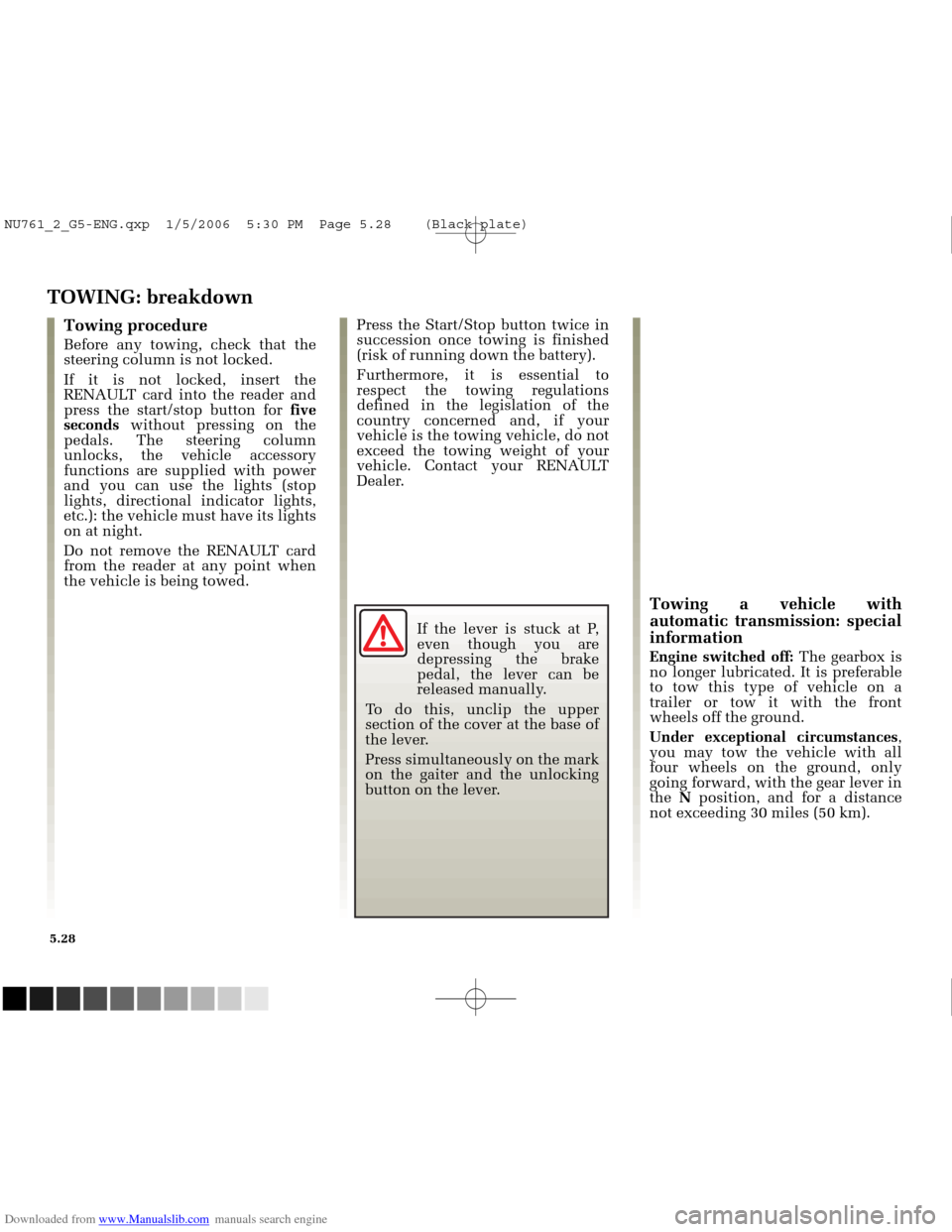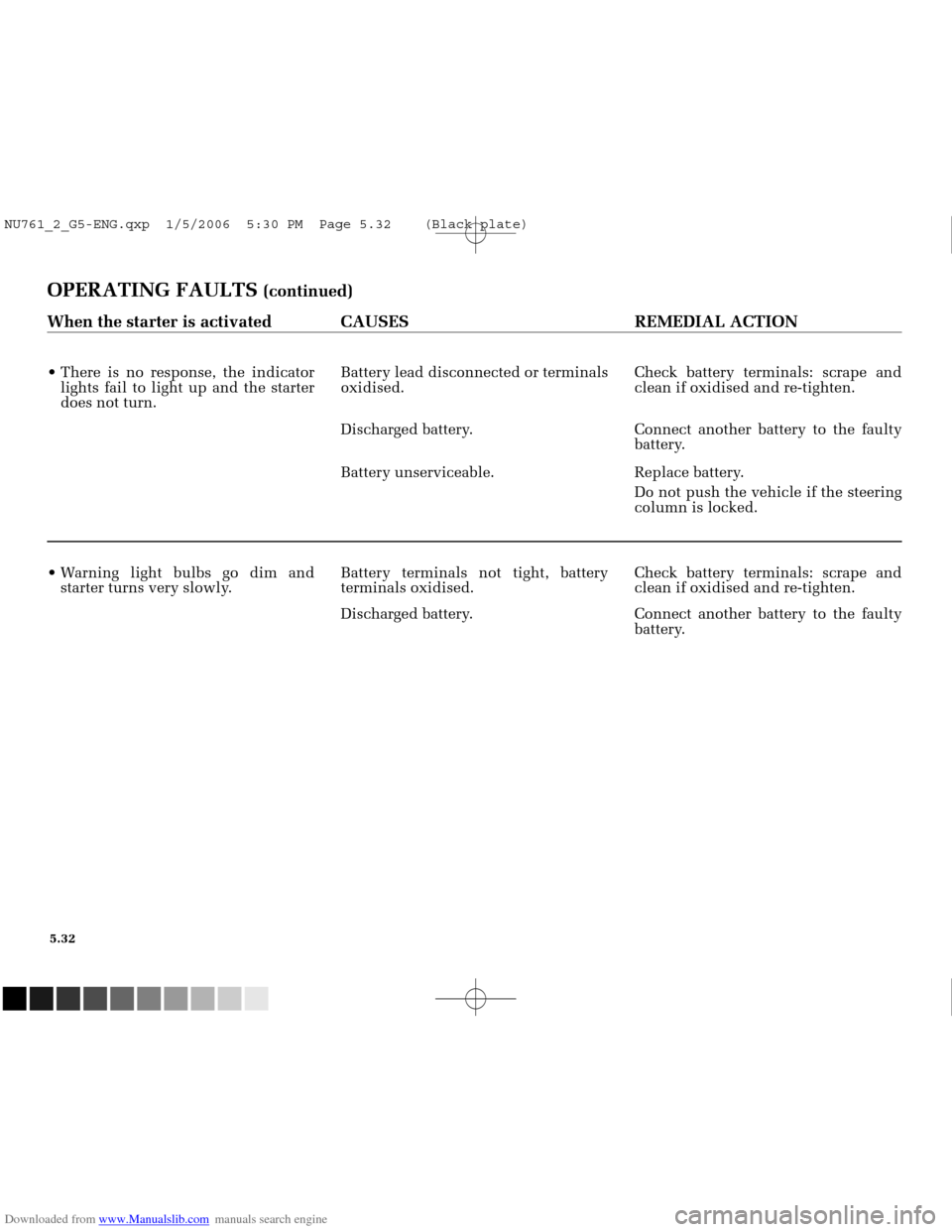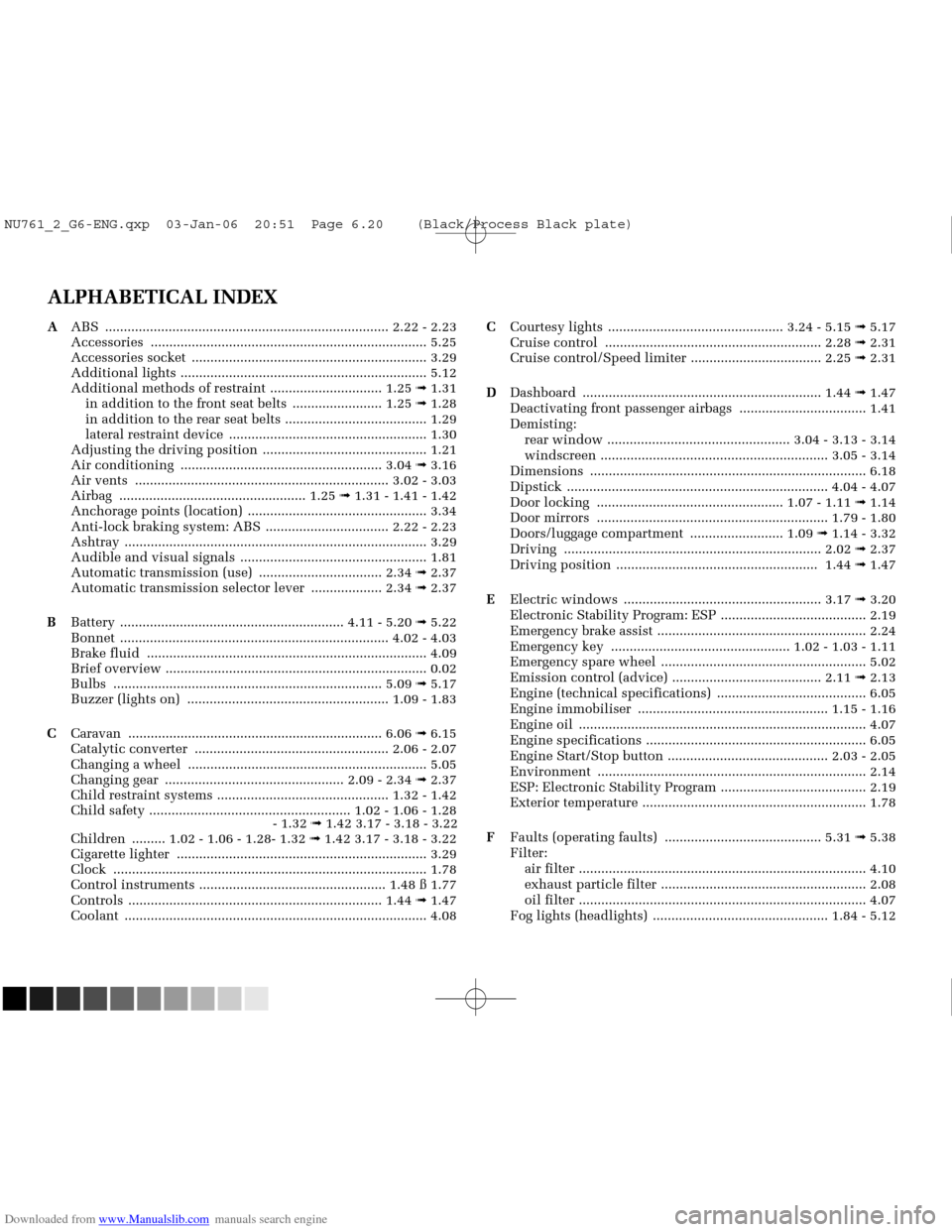2005 RENAULT MEGANE ESP
[x] Cancel search: ESPPage 209 of 250

Downloaded from www.Manualslib.com manuals search engine
NU761_2_G5-FRA.qxd 4/11/05 11:09 Page 5.21
5.21
BATTERY: troubleshooting (continued)
Connecting a battery charger
The battery charger should be
compatible with a battery with a
nominal voltage of 12 Volts.
With the engine switched off, it is
essential to disconnect the cables
connected to both battery terminals,
starting with the negative terminal .
Do not disconnect the battery when
the engine is running. Follow the
manufacturer’s instructions for the
battery charger you are using.
Only a well-charged and well-
maintained battery will have a long
and useful life and enable you to
start the vehicle’s engine normally.
The battery must be kept clean and
dry.
Have the battery’s charge status
checked regularly:
Especially if you use your vehicle for short journeys or for frequent
driving in town. When the external temperature
drops (in winter), the charge
decreases . In winter, only use
electrical equipment which is
really necessary.
Finally, you should understand that the charge decreases naturally
as a result of certain “permanent
electrical consumers” such as the
clock, After-Sales accessories, etc.
When many accessories are fitted to
the vehicle, have them connected
to + after ignition feed . In this case,
it is advisable to have your vehicle
fitted with a battery which has an
increased capacity. Contact your
RENAULT Dealer. If your vehicle is to be left stationary
for a relatively long time, disconnect
the battery or have it recharged
regularly, in particular during cold
weather. The equipment with a
memory, radio etc. will then have to
be reprogrammed. The battery must
be stored in a cool dry place,
protected from frost.
Special procedures may
be required to charge
some batteries. Contact
your RENAULT Dealer.
Avoid all risk of sparks which
may cause an immediate
explosion and charge the battery
in a well-ventilated area. Risk of
serious injury.
NU761_2_G5-ENG.qxp 1/5/2006 5:30 PM Page 5.21 (Black plate)
Page 211 of 250

Downloaded from www.Manualslib.com manuals search engine
24089
2
1
NU761_2_G5-FRA.qxd 4/11/05 11:09 Page 5.23
5.23
RENAULT CARD: BATTERY
Replacing the battery
The message “Change card battery”
appears on the instrument panel.
Pull firmly on emergency key 2.
Replace battery 1, observing the
polarity shown on the emergency key.
After the operation, the “Change
card battery” message no longer
appears on the instrument panel.
Batteries can be obtained from your
RENAULT Dealer.
These batteries should last about
two years.
Do not throw away your
used batteries, give them to
an organisation responsible
for collecting and recycling
batteries.
NU761_2_G5-ENG.qxp 1/5/2006 5:30 PM Page 5.23 (Black plate)
Page 216 of 250

Downloaded from www.Manualslib.com manuals search engine
NU761_2_G5-FRA.qxd 4/11/05 11:10 Page 5.28
5.28
TOWING: breakdown
Press the Start/Stop button twice in
succession once towing is finished
(risk of running down the battery).
Furthermore, it is essential to
respect the towing regulations
defined in the legislation of the
country concerned and, if your
vehicle is the towing vehicle, do not
exceed the towing weight of your
vehicle. Contact your RENAULT
Dealer.Towing procedure
Before any towing, check that the
steering column is not locked.
If it is not locked, insert the
RENAULT card into the reader and
press the start/stop button for five
seconds without pressing on the
pedals. The steering column
unlocks, the vehicle accessory
functions are supplied with power
and you can use the lights (stop
lights, directional indicator lights,
etc.): the vehicle must have its lights
on at night.
Do not remove the RENAULT card
from the reader at any point when
the vehicle is being towed.
Towing a vehicle with
automatic transmission: special
information
Engine switched off: The gearbox is
no longer lubricated. It is preferable
to tow this type of vehicle on a
trailer or tow it with the front
wheels off the ground.
Under exceptional circumstances ,
you may tow the vehicle with all
four wheels on the ground, only
going forward, with the gear lever in
the N position, and for a distance
not exceeding 30 miles (50 km).
If the lever is stuck at P,
even though you are
depressing the brake
pedal, the lever can be
released manually.
To do this, unclip the upper
section of the cover at the base of
the lever.
Press simultaneously on the mark
on the gaiter and the unlocking
button on the lever.
NU761_2_G5-ENG.qxp 1/5/2006 5:30 PM Page 5.28 (Black plate)
Page 220 of 250

Downloaded from www.Manualslib.com manuals search engine
NU761_2_G5-FRA.qxd 4/11/05 11:10 Page 5.32
OPERATING FAULTS (continued)
When the starter is activated CAUSES REMEDIAL ACTION
There is no response, the indicator lights fail to light up and the starter
does not turn. Battery lead disconnected or terminals
oxidised.
Check battery terminals: scrape and
clean if oxidised and re-tighten.
Discharged battery. Connect another battery to the faulty battery.
Battery unserviceable. Replace battery. Do not push the vehicle if the steering
column is locked.
Warning light bulbs go dim and starter turns very slowly. Battery terminals not tight, battery
terminals oxidised. Check battery terminals: scrape and
clean if oxidised and re-tighten.
Discharged battery. Connect another battery to the faulty battery.
5.32
NU761_2_G5-ENG.qxp 1/5/2006 5:30 PM Page 5.32 (Black plate)
Page 246 of 250

Downloaded from www.Manualslib.com manuals search engine
NU761_2_G6-FRA.qxd 4/11/05 11:11 Page 6.20
ALPHABETICAL INDEX
AABS ........................................................................\
.... 2.22 - 2.23
Accessories ............................................................\
.............. 5.25
Accessories socket ............................................................... 3.29
Additional lights .................................................................. 5.12
Additional methods of restraint .............................. 1.25 ➟ 1.31
in addition to the front seat belts ........................ 1.25 ➟ 1.28
in addition to the rear seat belts ...................................... 1.29
lateral restraint device ..................................................... 1.30
Adjusting the driving position ............................................ 1.21
Air conditioning ...................................................... 3.04 ➟ 3.16
Air vents .................................................................... 3.02 - 3.03
Airbag .................................................. 1.25 ➟ 1.31 - 1.41 - 1.42
Anchorage points (location) ................................................ 3.34
Anti-lock braking system: ABS ................................. 2.22 - 2.23
Ashtray ................................................................\
................. 3.29
Audible and visual signals .................................................. 1.81
Automatic transmission (use) ................................. 2.34 ➟ 2.37
Automatic transmission selector lever ................... 2.34 ➟ 2.37
B Battery ............................................................ 4.11 - 5.20 ➟ 5.22
Bonnet ........................................................................\
4.02 - 4.03
Brake fluid ........................................................................\
... 4.09
Brief overview ...................................................................... 0.02
Bulbs ..................................................................\
...... 5.09 ➟ 5.17
Buzzer (lights on) ...................................................... 1.09 - 1.83
C Caravan ................................................................\
.... 6.06 ➟ 6.15
Catalytic converter .................................................... 2.06 - 2.07
Changing a wheel ................................................................ 5.05
Changing gear ................................................ 2.09 - 2.34 ➟ 2.37
Child restraint systems .............................................. 1.32 - 1.42
Child safety ...................................................... 1.02 - 1.06 - 1.28 - 1.32➟ 1.42 3.17 - 3.18 - 3.22
Children ......... 1.02 - 1.06 - 1.28- 1.32 ➟ 1.42 3.17 - 3.18 - 3.22
Cigarette lighter ................................................................... 3.29
Clock ..................................................................\
.................. 1.78
Control instruments .................................................. 1.48 ß 1.77
Controls ...............................................................\
..... 1.44 ➟ 1.47
Coolant ................................................................\
................. 4.08 C
Courtesy lights ............................................... 3.24 - 5.15 ➟ 5.17
Cruise control .......................................................... 2.28 ➟ 2.31
Cruise control/Speed limiter ................................... 2.25 ➟ 2.31
D Dashboard ..............................................................\
.. 1.44 ➟ 1.47
Deactivating front passenger airbags .................................. 1.41
Demisting: rear window ................................................. 3.04 - 3.13 - 3.14
windscreen ............................................................. 3.05 - 3.14
Dimensions .............................................................\
............. 6.18
Dipstick ...................................................................... 4.04 - 4.07
Door locking .................................................. 1.07 - 1.11 ➟ 1.14
Door mirrors .............................................................. 1.79 - 1.80
Doors/luggage compartment ......................... 1.09 ➟ 1.14 - 3.32
Driving ................................................................\
..... 2.02 ➟ 2.37
Driving position ...................................................... 1.44 ➟ 1.47
E Electric windows ..................................................... 3.17 ➟ 3.20
Electronic Stability Program: ESP ....................................... 2.19
Emergency brake assist ........................................................ 2.24
Emergency key ................................................ 1.02 - 1.03 - 1.11
Emergency spare wheel ....................................................... 5.02
Emission control (advice) ........................................ 2.11 ➟ 2.13
Engine (technical specifications) ........................................ 6.05
Engine immobiliser ................................................... 1.15 - 1.16
Engine oil ........................................................................\
..... 4.07
Engine specifications ........................................................... 6.05
Engine Start/Stop button ........................................... 2.03 - 2.05
Environment ............................................................\
............ 2.14
ESP: Electronic Stability Program ....................................... 2.19
Exterior temperature ............................................................ 1.78
F Faults (operating faults) .......................................... 5.31 ➟ 5.38
Filter: air filter ........................................................................\
..... 4.10
exhaust particle filter ....................................................... 2.08
oil filter ........................................................................\
..... 4.07
Fog lights (headlights) ............................................... 1.84 - 5.12
NU761_2_G6-ENG.qxp 03-Jan-06 20:51 Page 6.20 (Black/Process Black\
plate)
Page 249 of 250

Downloaded from www.Manualslib.com manuals search engine
NU761_2_Gcv-FRA.qxd 4/11/05 11:12 Page 3
BC84 - NU761-2C:\Documentum\Checkout\NU761_2_Tcv-ENG.win 7/12/2005 9:13- page 2
has chosen ELF
Engines of all types
except 1. 9 dCi wi th
particle filter
1.9 dCi engines
with particle filter
Petrol and LPG engines
except 2.0T 16V
Renault Sport
Engine all types except
2.0T 16V Renault Sport
and 1.9 dCi with a par-
ticle filter
Gearbox
ELF EXCELLIUM LDX 5W-40ACEA A3 / B4Optimum performance and maximum protection in the most severe conditions
All types of driving
ELF EVOLUTION SXR 5W-40ACEA A3 / B4
Optimum performance
All types of driving
ELF SOLARIS RNX 5W-30ACEA C3
Optimum performance, par ticle filter protection and respect for the environment
All types of driving
ELF EVOLUTION SXR 5W-30ACEA A5 / B5
Fuel economy, engine protection and respect for the environment.
All types of driving
ELF COMPETITION ST 10W-40
ELF TURBO DIESEL 10W-40ACEA A3 / B4
ACEA B3 / B4
Other RENAULT approved lubricants for normal use.
Elf has developed specific lubricants for each Renault transmission:Tranself TRJ 75W80, Tranself TRT 75W80, Tranself TRP 75W80, Tranself TRX 75W80 for manual
gearboxes, Renaultmatic D3Syn and Renaultmatic D2 for automatic transmissions.These fluids are actively involved in the operation of your vehicle. (*)
RENAULT recommends using approved ELF products when topping up or changing the oil.
(*) Refer to your vehicle's Warranty and Services booklet for information regarding which grade of oil to use.
Consult your RENAULT Dealer or visit www.lubricants.elf.com